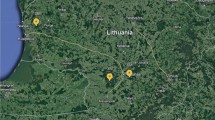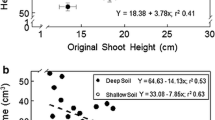Summary
Analysis of 62 mature Norway spruce (Picea abies provenance “Viborg”) trees growing in a Danish plantation was undertaken along with analysis of their nutrient contents (N, P, K, Ca, Mg, Fe, Mn, Cu, Zn, B and Na), in each of the three youngest needle age classes, from branches of four exposure directions near the tree top. The aim was to investigate if one among the studied possible predisposing factors was also a triggering factor in the 1989 outbreak of the “Red” Norway spruce decline in Denmark. Neither nutrient imbalance or deficiency, nor excessive N-deposition or salt-stress were indicated as triggering factors in 1989. The “Red” syndrome, noticeable for the bright red colour of the current-year needles, was found to be an extension of the European type “Novel Decline”. “Red” syndrome is similar to previously reported phenomena of “top-dying” and “sub top-dying”, in that it had fewer needle age classes and significantly higher contents of mobile cations (and Ca) in the younger needle classes. Tree ring analysis suggested that the “Red” syndrome was initiated in the early 1980s, when the trees experienced adverse climatic conditions. Because of this long-term development of the “Red” Norway spruce decline syndrome, it is concluded that a triggering factor is of minor importance relative to the multitude of predisposing factors.
Similar content being viewed by others
References
Anonymous (1990) Sanasilva tree crown photos, 2nd edn. Swiss Federal Institute for Forest, Snow and Landscape Research, Birmensdorf, Switzerland
Barklund P (1983) Die-back in mature and young Norway spruce, plausible causes: drought, frost, acid precipitation, fungi. SST 2/83: 29–40
Bolhàr-Nordenkampf R (1989) Stress-physiological ecosystem research. Altitude profile Zillertal. Phyton 29: 11–302
Cape JN, Freer-Smith PH, Paterson IS, Parkinson JA, Wolfenden J (1990) The nutritional status of Picea abies (L.) Karst. across Europe, and implications for “forest decline”. Trees 4: 221–224
Dahl E (1990) Probable effects of climatic change due to the greenhouse effect on plant productivity and survival in North Europe. In: Holten JI (ed) Effects of climate change on terrestrial ecosystems. Report from a seminar in Trondheim, 16 January 1990. NINA, Trondheim, Norway
Dobson MC, Taylor G, Freer-Smith PH (1990) The control of ozone uptake by Picea abies (L.) Karst. and P. sitchensis (Bong.) Carr. during drought and interacting effects on shoot water relations. New Phytol 116: 465–474
Dragsted J (1973) Salt injuries along a Jutland country road (in Danish) Dansk Skov foren Tidsskr 58: 72–90
Elstner EF, Osswald W, Youngman RJ (1985) Basic mechanisms of pigment bleaching and loss of structural resistance in spruce (Picea abies) needles: advances in phytomedical diagnostics. Experientia 41:591–597
Freer-Smith PH, Dobson MC (1989) Ozone flux to Picea sitchensis (Bong) Carr and Picea abies (L.) Karst. during short episodes and the effects of these on transpiration and photosynthesis. Environ Pollut 116:465–474
Hertel O, Hovmand MF (1991) Rural ozone measurement in Denmark, 1985–89. Ministry of the Environment, National Environmental Research Institute, Denmark
Huettl RF, Fink S, Lutz H-J, Poth M, Wisniewski J (1990) Forest decline, nutrient supply and diagnostic fertilization in Southwestern Germany and in Southern California. For Ecol Manage 30: 341–350
Landmann G (ed) (1991) French research into forest decline. DER-FORPA Program: forest decline and air pollution — 2nd report. ENG. REF, Nancy, France
Larsen JB (1983) Trockenresistenz, Wasserhaushalt und Wachstum Junger Douglasien (Pseudotsuga menziesii) und Küstentannen (Abies grandis) in Abhängigkeit von der Nährstoffversorgung. Forstl Forsoegsvaes Dan 39: 1–81
Larsen JB, Yang W, Tiedemann AV (1990) Effects of ozone on gas exchange, frost resistance, flushing and growth of different provenances of European silver fir (Abies alba Mill). Eur J For pathol 20:211–218
Lees JA (1991) A dendrochronological investigation into factors affecting “top dying” of Norway spruce [Picea abies (L.) Karst.] in England and Wales. Department of Geography, Coventry Polytechnic, England
Lövblad G, Amann M, Andersen B, Hovmand M, Joffre S, Pedersen U (1992) Deposition of sulfur and nitrogen in the Nordic countries: present and future. Ambio 21: 339–347
Lundberg J, Ravnsbæk PFV (1992) Forestry Fertilization on Heath Land (in Danish), Danish Land Development Service, Viborg
Manion PD (1981) Decline diseases of complex biotic and abiotic origin. In: Manion PD (ed) Tree disease concepts. Prentice Hall, Englewood Cliffs, N.J., pp 324–339
Markan K, Fischer U (1991) Untersuchungen zur Imissionsbelastung der Berliner Forsten: Deposition und Bioindikation. Diss Bot 170: 250
McLaughlin SB (1992) Forest declines: some perspectives on linking processes and patterns. Procedings of the third international symposium on gaseous pollutants and plant metabolism, 13–16 June 1992. VPI, Blacksburg, Va., USA
Neighbour EA, Pearson M, Mehlhorn H (1990) Purafil-filtration prevents the development of ozone-induced frost injury: a potential role for nitric oxide. Atmos Environ 24: 711–715
Nienhaus F (1985) Infectious diseases in forest trees caused by viruses, mycoplasma-like organisms and primitive bacteria. Experientia 41: 597–603
Nihlgaard B (1985) The ammonia hypothesis — an additional explanation to the forest die-back in Europe. Ambio 14:2–8
Nygaard E (1990) Notice on the Red Syndrome of Norway spruce (in Danish). National Forest and Nature Agency, Hørsholm
Pedersen LB (1992) Salt stresses Norway spruce in many ways (in Danish). Dansk Skovforen Tidsskr 77: 43–54
Prinz H (1936) Respiratory loss as a plant geographic factor in mild winter coastal regions (in Norwegian). Skogbrukeren 4: 57–61
Riitters KH, Ohmann LF, Grigal DF (1991) Woody tissue analysis using an element ratio technique (DRIS). Can J For Res 21: 1270–1277
Röhrig E (1982) Waldbau auf Ökologischer Grundlage (begründet von A. Dengler). Parey, Hamburg
Salisbury FB, Ross CW (1992) Plant physiology. Wadsworth, Belmont, Calif
Saxe H (1990) Air pollution, primary plant physiological responses, and diagnostic tools. Dr. Agro Thesis, Royal Veterinary and Agricultural University, Copenhagen, iii: 2–3
Saxe H (1991) Photosynthesis and stomatal responses to polluted air, and the use of physiological and biochemical responses for early detection and diagnostic tools. Adv Bot Res 18: 1–128
Saxe H (1993) Physiological and biochemical tools in diagnosis of forest decline and air pollution injury to plants. In: Yunus M, Iqbal M (eds) Plant growth and air pollution. Springer, Berlin Heidelberg New York (in press)
Schulze E-D, Freer-Smith PH (1991) Air pollution and forest decline based on field observations focused on Norway spruce. Proc R Soc Edinb 97B: 156–168
Shriner DS, Heck WW, McLaughlin SB, Johnson DW, Peterson CE (1991) Responses of vegetation to atmospheric deposition and air pollution, vol 18. NAPAP, USA
Siegel S, Castellan NJ Jr (1988) Nonparametric statistics for the behavioral sciences, 2nd edn. McGraw-Hill, London
Skeffington RA, Wilson EJ (1988) Excess nitrogen deposition: issues for consideration. Environ Pollut 54: 159–189
Skelly JM, Davis DD, Cameron EA, Brown HD, Drummond DB, Dochinger LS (1987) Diagnosing injury to Eastern forest trees. USDA, Forest Service, Forest Pest Management, Atlanta, Ga., USA
Tynnyrinen S, Palomäki V, Holopainen T, Kärenlampi L (1992) Comparison of several bioindicator methods in monitoring the effects on forest of a fertilizer plant and a strip mine. Ann Bot Fenn 29: 11–24
Wallin G, Skärby L, Selldén G (1990) Long-term exposure of Norway spruce, Picea abies (L.) Karst., to ozone in open-top chambers I. Effects on the capacity of net photosynthesis, dark respiration and leaf conductance of shoots of different ages. New Phytol 115: 335–344
Weikert RM, Wedler M, Lippert M, Schramel P, Lange OL (1989) Photosynthetic performance, chloroplast pigments, and mineral content of various needle age classes of spruce (Picea abies) with and without the new flush: an experimental approach for analyzing forest decline phenomena. Trees 3: 161–172
Yde-Andersen NA (1991) “Red” Norway spruce (in Danish). Skoven 1: 26–28
Zöttl HW, Mies E (1983) Supply with mineral nutrients and pollution stress of spruce ecosystems in the Black Forest being under immission influence. Mitt Dtsch Bodenkd Ges 38: 429–434
Author information
Authors and Affiliations
Rights and permissions
About this article
Cite this article
Saxe, H. Triggering and predisposing factors in the “Red” decline syndrome of Norway spruce (Picea abies). Trees 8, 39–48 (1993). https://doi.org/10.1007/BF00240980
Received:
Issue Date:
DOI: https://doi.org/10.1007/BF00240980




